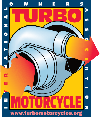|
Tech
Help
1982 Honda CX500TC Turbo

1983 Honda CX650TD Turbo
|
|
|
Sticking
Automatic Camchain Tensioner
Some
of Honda's automatic camchain tensioners have a propensity to fail to
take up the slack in a camchain as it wears. I have not personally
experienced a problem on my CXT's, but I know that other Hondas have.
I bring it up, in part, because our bikes do have automatic
tensioners. Mainly, I bring this subject up in light of a report from
Colin Goodall at his Web site, as reprinted in Turbo News #27. In a
nutshell: With 75,000 miles on his CX500TC (big pat on the back!) he
found the need to replace his camchain. The bike had steadily
developed a louder and louder rattling from the engine cases. The
upper camshaft sprocket had also worn well beyond serviceable limits,
and required replacing. Mr. Goodall noted that the lower sprocket,
which is part of the crankshaft, was in fine shape. His analysis of
the situation is twofold: A) The camchain wore, causing the upper
sprocket to wear out. B) The upper sprocket wear may also be
attributable to its location farther from the oil bath below. Perhaps
these are valid points.
However,
my experience with camchains in the CX engines has been very
favorable. I currently also ride a CX500 Deluxe which has racked up
over 130,000 miles on it's camchain. I closely examined the camchain
and sprockets at 120,000 miles, and found no abnormal wear. The chain
is the same type as found in the Turbos, but instead of an automatic
tensioner, my CX500 requires me to manually tension the chain every
3000 miles. The system is whisper quiet to this day, with never a
hint of rattling sounds. Oh yes, there is one occasion when I heard
MAJOR rattling sounds from the rear of the engine. That was at 87,000
miles, when the righthand camchain tensioner guide suddenly broke,
allowing the chain to rattle about freely with way too much slack.
This rather points the direction in which I shall go in my analysis
of Mr. Goodall's experience.
I
believe Mr. Goodall's camchain/sprocket problem was not caused by
wear, or lack of upper engine lubrication. A rattle is always an
indication that something is loose, but not necessarily worn.
Camchains have a wonderful record of reliability, but they do
continue to stretch over their normal life. This is why I must
continually take up the slack in the camchain on my CX500D every 3000
miles. And this is also what you are blindly hoping the automatic
camchain tensioner is doing for your Turbo's camchain. I believe that
all indicators suggest that the automatic tensioner in Mr. Goodall's
engine became stuck. The chain gradually kept stretching, while the
tensioner failed to take up the slack. This would bring about his
observation that "the bike had steadily developed a louder and
louder rattling from the engine cases...". The more the chain
stretched, the looser it got, the more it rattled. Period.
Yet,
what could cause the upper sprocket to wear severely, while the lower
sprocket remains fine? Could it be a deficiency of lubrication in the
upper reaches of the engine case? It is not entirely impossible. Yet,
imagine what a loose camchain is doing within the engine. Imagine
viewing the crankshaft/chain/upper sprocket from the rear of the
engine. The automatic tensioner push rod presses against the
tensioner slipper, which is ideally kept snug up against the
righthand vertical run of the chain. From the rear, the pistons
rotate the crankshaft counterclockwise. This naturally keeps the
lefthand vertical run of the chain taught, pulling against the
tension created by the valve springs. All slack in the chain will
always be manifest in the righthand side of the chain run This is why
the tensioner is situated there. As the chain stretches gradually,
the tensioner should push gradually, increasingly inward to maintain
a constant tension on the righthand chain run. Now imagine the
tensioner hanging up in it's travel, refusing to push to the left any
further, while the chain gradually continues to stretch. Excessive
slack is now becoming present, and it is this slack which causes the
chain to now slap violently up against the upper camchain sprocket.
Such continued abuse will rapidly wear both the chain and the upper
sprocket. Anyone who has observed the action of a loose chain knows
that the sprocket receiving the loose chain bears the brunt of the
beating, in this case the upper sprocket. The crankshaft sprocket
remains relatively unaffected since it is pulling the chain downward
from the left side of the run, constantly under back tension from the
valve springs. This keeps everything on the left side taught.
Should
anyone's Turbo experience the symptoms which Mr. Goodall's did,
suspect first the tensioner. I would certainly have sympathy for
anyone who goes to the great trouble to replace a camchain and
sprocket worn, unbeknownst to him, from the slack created by a
sticking tensioner, while failing to recognize the tensioner itself
as the source of the problem. If Mr. Goodall overlooked this
possibility, hopefully the very process of replacing the chain freed
up the sticky tensioner, since it must be fully removed in order to
replace the chain. The proper initial examination procedure, should
one ever have access to the area, is to press in on the steel ball
within the tensioner with a screwdriver, allowing you to assess the
presence, or lack, of unrestricted motion in the push rod. I would
further completely disassemble the tensioning system and inspect for
wear and galling on all moving parts. Particularly if you are already
experiencing symptoms, be certain to check for breakage in the spring
hidden inside the tensioner which wedges the small steel ball into
the rear of the push rod. See page 23-10 of the Honda service manual.
Disclaimer
©
Turbo Motorcycle International Owners Association

